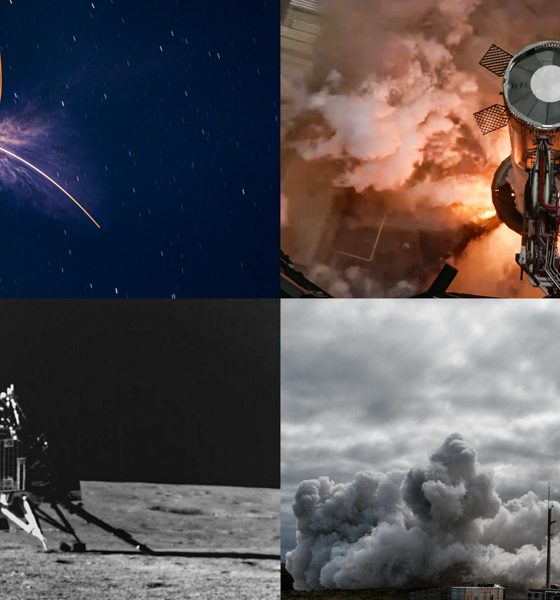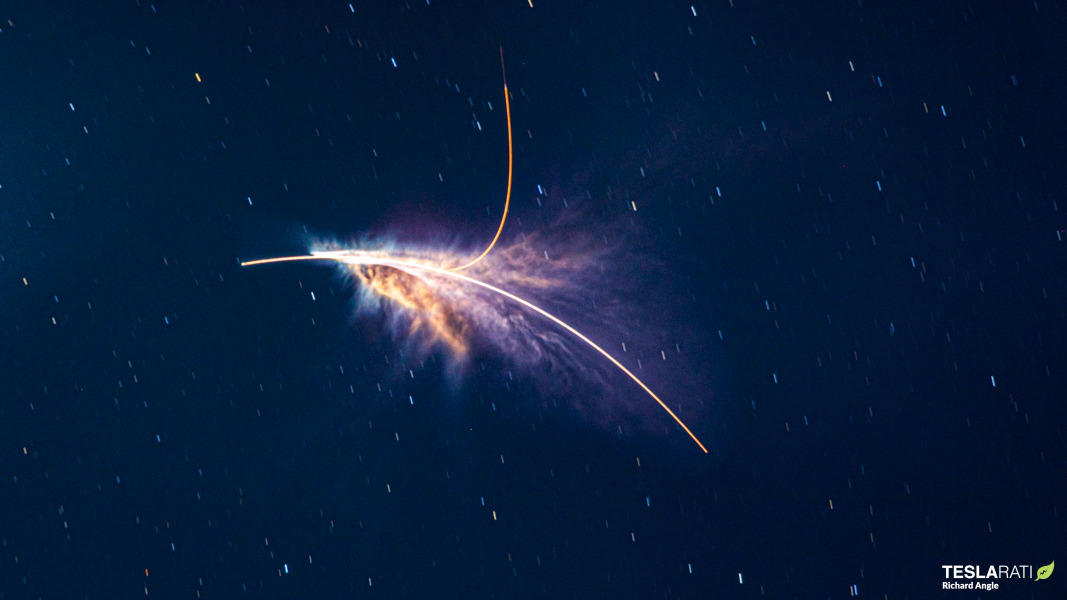

News
Weekly Space Recap: August 21 – August 27
Here are some of the stories you may have missed in the past week. The fourth week of August 2023 featured SpaceX hitting a Starlink milestone, India landing on the Moon, Rocket Lab moving forward with reusability, and more Starship testing.
SpaceX launches 100th dedicated Starlink mission – Starlink Group 7-1 launched from California and deployed 21 V2 mini-satellites into orbit following a short delay caused by Hurricane Hilary. This mission also featured the 15th flight of Booster 1061.
India lands Chandrayaan-3 on the Moon – India became the 4th country to successfully land on the Moon and landed the closest to the Southern pole of any country. After landing, The Pragyan rover was deployed and has begun roaming the surface of the Moon conducting experiments, and the Vikram lander has also begun its own set of experiments during the ~12-day mission.
Beyond Borders, Across Moonscapes:
India’s Majesty knows no bounds!.Once more, co-traveller Pragyan captures Vikram in a Snap!
This iconic snap was taken today around 11 am IST from about 15 m.
The data from the NavCams is processed by SAC/ISRO, Ahmedabad. pic.twitter.com/n0yvXenfdm
— ISRO (@isro) August 30, 2023
Rocket Lab launches 40th mission – After issues on the original Electron assigned to this mission, Rocket Lab switched it out for a booster intended for recovery, and it featured the reuse of a Rutherford engine. CEO Peter Beck said the first stage and re-used engine performed perfectly, and the booster was recovered from the ocean for analysis as the company moves closer to reusing the entire first-stage rocket.
Starship performs 2nd static fire test – After a trip to the production site to add a hot stage ring, Booster 9 rolled back to the launch site for a series of tests culminating in a static fire. SpaceX confirmed all 33 engines ignited, but 2 shut down early during the ~5-second test fire. This is an improvement over the last static fire, which shut down early. Elon Musk has said they expect the next Starship test flight to happen “soon.”
Crew 7 launches and docks to the ISS – Crew 7 successfully launched from LC-39A on August 26th, and after a day of catching up to the Space Station, Crew Dragon Endurance autonomously docked. Crew 7 will now spend the next 6 months aboard the ISS, and sometime next week, Crew 6 will make its return to Earth.
Crew 7 continuing to orbit while the Falcon 9 first stage performs a boostback burn (Credit: Richard Angle)
5,000th Starlink launched into space – 22 V2 mini Starlinks launched from LC-40 in Florida the evening of the 26th, hours after the Crew 7 launch. This mission brought the total number of Starlink satellites launched to 5,005. This flight featured the 3rd flight, Booster 1081, which successfully landed on the droneship. However, that booster has still not arrived back in Port Canaveral, the port is closed due to high winds from Hurricane Idalia passing to the North.
ULA readies for the first Atlas V launch of the year – The Atlas V was rolled to the LC-41 in Florida and prepped for launch, but due to Hurricane Idalia, ULA rolled the Atlas V back to the Vertical Integration Facility to keep the rocket and secretive NRO payload safe until the storm passes. ULA will confirm a new launch date soon.
What do you think of last week’s news? Rocket Lab made big strides for reusability, India became the 4th country to soft-land on the Moon, and as always, SpaceX was non-stop with Starship testing and Falcon 9 launches!
Thanks for reading the Weekly Space Recap!
Questions or comments? Shoot me an email at rangle@teslarati.com, or Tweet me @RDAnglePhoto.

Elon Musk
Elon Musk just said some crazy stuff about the Tesla Roadster

Elon Musk appeared on the Moonshots podcast with Peter Diamandis today to discuss AGI, U.S. vs. China, Tesla, and some other interesting topics, but there was some discussion about the upcoming unveiling of the Roadster, the company’s electric supercar that will arrive several years after it was initially slated for release.
Musk made some pretty amazing claims about the Roadster; we already know it is supposed to be lightning-fast and could even hover, if Tesla gets everything to happen the way it wants to. However, the car has some pretty crazy capabilities, some of which have not even been revealed.
On the podcast, Musk said:
“This is not a…safety is not the main goal. If you buy a Ferrari, safety is not the number one goal. I say, if safety is your number one goal, do not buy the Roadster…We’ll aspire not to kill anyone in this car. It’ll be the best of the last of the human-driven cars. The best of the last.”
🚨 Elon on the Roadster unveiling, scheduled for April 1:
— TESLARATI (@Teslarati) January 6, 2026
Musk makes a good point: people who buy expensive sports cars with ridiculous top speeds and acceleration rates do not buy them to be safe. They hope they are safe in case of an emergency or crash, but safety is not at the forefront of their thoughts, because nobody buys a car thinking they’ll crash it.
The Roadster is truly going to push the limits and capabilities of passenger vehicles; there’s no doubt about that. Tesla plans to show off the new version car for the first time on April 1, and Musk has only hinted at what is possible with it.
Musk said back in November:
“Whether it’s good or bad, it will be unforgettable. My friend Peter Thiel once reflected that the future was supposed to have flying cars, but we don’t have flying cars. I think if Peter wants a flying car, he should be able to buy one…I think it has a shot at being the most memorable product unveiling ever. [It will be unveiled] hopefully before the end of the year. You know, we need to make sure that it works. This is some crazy technology in this car. Let’s just put it this way: if you took all the James Bond cars and combined them, it’s crazier than that.”
Production is set to begin between 12 and 18 months after the unveiling, which would put the car out sometime in 2027. Hopefully, Tesla is able to stay on track with the scheduling of the Roadster; many people have been waiting a long time for it.
News
Tesla launches hiring for Robotaxi program in its twentieth country
Overall, the hiring signals Tesla’s aggressive timeline for global dominance in autonomous mobility.

Tesla has launched a hiring initiative for its Robotaxi program in its twentieth country, as the company posted two new jobs in Thailand this week.
Tesla is hiring in Bangkok and Kowloon for the Vehicle Operator position, which is related to data collection, and is the first in Thailand, but the twentieth country overall, as the company tries to expand into other markets.
🚨 BREAKING: Tesla is hiring additional full-time Vehicle Operators in Bangkok, Thailand.
Previous openings were 6-month, part-time roles. These are equivalent to AI Safety Operator roles in the U.S. pic.twitter.com/R6LzoU1bos— Tesla Yoda (@teslayoda) January 5, 2026
Tesla has had active job postings for Vehicle Operator positions in the United States, India, Israel, Taiwan, Germany, the Czech Republic, Hungary, the UK, Finland, Switzerland, Sweden, the Netherlands, Austria, Spain, Norway, Italy, and Turkey in past listings.
These postings are not all currently available, likely because the roles have been filled.
Thailand is the most recent, and broadens the company’s potential path to expanding its ride-hailing program, which is only active in the United States in Austin, Texas, and the California Bay Area, so far.
These roles typically involve data collection, which assists in improving Autopilot and Full Self-Driving operation. Tesla’s self-driving programs utilize real-world data that is accumulated and stored, observing vehicle and traffic behavior, as well as tendencies that are performed by human drivers to help increase safety and overall performance.
Overall, the hiring signals Tesla’s aggressive timeline for global dominance in autonomous mobility. Although the company has several high-profile rivals and competitors in the field, it has established itself as a main player and a leader in the development of autonomous technology, especially in the U.S., as its FSD suite is refined on almost a weekly basis.
The Full Self-Driving suite is available in seven countries and territories currently, including the U.S., Canada, China, Mexico, Puerto Rico, Australia, and New Zealand. Its biggest goal for expansion is currently the European market, where regulatory hurdles have been the main bottleneck prolonging its launch on the continent.
Tesla has performed months of testing in various European countries, including France and Spain, and does have support in some areas from various regulatory agencies. However, the company is hoping to get through this red tape and offer its suite in Europe for the first time, hopefully this year.
News
Tesla China rolls out Model Y upgrades, launches low-interest financing
These strategies are aimed at improving the ownership experience and keeping vehicle pricing competitive in the world’s largest electric vehicle market.

Tesla has rolled out minor updates to the five-seat Model Y in China, upgrading the vehicle’s center display to a higher-resolution 16-inch 2K screen. The electric vehicle maker also introduced attractive financing options, including 7-year low-interest rates, to offset the new purchase tax on EVs.
These strategies are aimed at improving the ownership experience and keeping vehicle pricing competitive in the world’s largest electric vehicle market.
Five-seat Model Y gets larger, better display
With its recent update, all three variants of the five-seat Model Y now feature an upgraded 16-inch 2K resolution center display, which replaces the vehicle’s previous 15.4-inch 1080p panel. This screen was already used in the six-seat Model Y L, and it offered improved visual clarity. Tesla China has also updated the Model Y’s headliner to black, giving the vehicle a sleeker appearance.
Prices of the five-seat Model Y remain unchanged at RMB 263,500, RMB 288,500, and RMB 313,500 for the respective trims. This update enhances the cabin experience as domestic rivals are already adopting high-resolution screens. As noted in a CNEV Post report, some domestic automakers have begun rolling out vehicles equipped with 3K-resolution displays.
New financing offers
Tesla also launched ultra-long-term financing offers for its locally produced models in China, which include the Model 3 sedan, the five-seat Model Y, and the six-seat Model Y L, through January 31, 2026. The 7-year option features an annualized fee rate as low as 0.5%, which is equivalent to 0.98% interest. This is expected to save customers up to RMB 33,479 ($4,790) compared to standard rates.
A 5-year zero-interest plan is also available, and it has been extended to the Tesla Model Y L for the first time. These incentives help offset China’s new 5% purchase tax on New Energy Vehicles (NEVs) in 2026-2027. Some of Tesla’s rivals in China have announced in recent months that they would be covering the purchase tax owed by buyers early this year.








